Effect of Support on Steam Reforming of Ethanol for H2 Production with Copper-Based Catalysts
Abstract
1. Introduction
2. Materials and Methods
2.1. Material
2.2. Methods
2.2.1. Catalyst Preparation
2.2.2. Catalyst Characterization
2.2.3. Catalytic Performance Evaluation
3. Results and Discussion
3.1. Catalyst Characterization
3.1.1. Morphology
3.1.2. Crystallinity
3.1.3. Textural Parameters
3.1.4. Temperature-Programmed Desorption (TPD)
3.1.5. Temperature-Programmed Reduction (TPR)
3.2. Catalytic Performance Evaluation
4. Conclusions
Author Contributions
Funding
Data Availability Statement
Acknowledgments
Conflicts of Interest
References
- Luo, M.; Li, S.; Di, Z.; Yang, Z.; Chou, W.; Shi, B. Fischer-Tropsch Synthesis: Effect of Nitric Acid Pretreatment on Graphene-Supported Cobalt Catalyst. Appl. Catal. A Gen. 2020, 599, 117608. [Google Scholar] [CrossRef]
- Yousefian, F.; Babatabar, M.A.; Eshaghi, M.; Poor, S.M.; Tavasoli, A. Pyrolysis of Rice Husk, Coconut Shell, and Cladophora Glomerata Algae and Application of the Produced Biochars as Support for Cobalt Catalyst in Fischer–Tropsch Synthesis. Fuel Process. Technol. 2023, 247, 107818. [Google Scholar] [CrossRef]
- Liu, Y.; Zou, R.; Qin, B.; Gan, J.; Peng, X. Energy-Efficient Monosaccharides Electrooxidation Coupled with Green Hydrogen Production by Bifunctional Co9S8/Ni3S2 Electrode. Chem. Eng. J. 2022, 446, 136950. [Google Scholar] [CrossRef]
- Mert, M.E.; Edis, C.; Akyıldız, Ş.; Demir, B.N.; Nazligul, H.; Gurdal, Y.; Doğru Mert, B. Design and Performance Analysis of a PV-Assisted Alkaline Electrolysis for Hydrogen Production: An Experimental and Theoretical Study. Fuel 2024, 355, 129497. [Google Scholar] [CrossRef]
- Vadalà, M.; Kröll, E.; Küppers, M.; Lupascu, D.C.; Brunstermann, R. Hydrogen Production via Dark Fermentation by Bacteria Colonies on Porous PDMS-Scaffolds. Int. J. Hydrogen Energy 2023, 48, 25274–25284. [Google Scholar] [CrossRef]
- Öztan, H.; Çapoğlu, İ.K.; Uysal, D.; Doğan, Ö.M. A Parametric Study to Optimize the Temperature of Hazelnut and Walnut Shell Gasification for Hydrogen and Methane Production. Bioresour. Technol. Rep. 2023, 23, 101581. [Google Scholar] [CrossRef]
- Guan, D.; Wang, F.; Zhang, X.; Dou, W.; Sun, Y. Comprehensive Study on Catalytic Coating Tubular Reactor with Electromagnetic Induction Heating for Hydrogen Production through Methanol Steam Reforming. Int. J. Hydrogen Energy 2024, 50, 1–17. [Google Scholar] [CrossRef]
- Hu, Y.; He, W.; Shen, Y. Recyclable NiMnOx/NaF Catalysts: Hydrogen Generation via Steam Reforming of Formaldehyde. Fuel 2023, 354, 129311. [Google Scholar] [CrossRef]
- Zoppi, G.; Pipitone, G.; Gruber, H.; Weber, G.; Reichhold, A.; Pirone, R.; Bensaid, S. Aqueous Phase Reforming of Pilot-Scale Fischer-Tropsch Water Effluent for Sustainable Hydrogen Production. Catal. Today 2021, 367, 239–247. [Google Scholar] [CrossRef]
- Levikhin, A.A.; Boryaev, A.A. High-Temperature Reactor for Hydrogen Production by Partial Oxidation of Hydrocarbons. Int. J. Hydrogen Energy 2023, 48, 28187–28204. [Google Scholar] [CrossRef]
- da Silva, F.A.; Dancini-Pontes, I.; DeSouza, M.; Fernandes, N.R.C. Kinetics of Ethanol Steam Reforming over Cu–Ni/NbxOy Catalyst. React. Kinet. Mech. Catal. 2017, 122, 557–574. [Google Scholar] [CrossRef]
- Shtyka, O.; Dimitrova, Z.; Ciesielski, R.; Kedziora, A.; Mitukiewicz, G.; Leyko, J.; Maniukewicz, W.; Czylkowska, A.; Maniecki, T. Steam Reforming of Ethanol for Hydrogen Production: Influence of Catalyst Composition (Ni/Al2O3, Ni/Al2O3–CeO2, Ni/Al2O3–ZnO) and Process Conditions. React. Kinet. Mech. Catal. 2021, 132, 907–919. [Google Scholar] [CrossRef]
- Haryanto, A.; Fernando, S.; Murali, N.; Adhikari, S. Current Status of Hydrogen Production Techniques by Steam Reforming of Ethanol: A Review. Energy Fuels 2005, 19, 2098–2106. [Google Scholar] [CrossRef]
- Zanchet, D.; Santos, J.B.O.; Damyanova, S.; Gallo, J.M.R.; Bueno, J.M.C. Toward Understanding Metal-Catalyzed Ethanol Reforming. ACS Catal. 2015, 5, 3841–3863. [Google Scholar] [CrossRef]
- Trane-Restrup, R.; Dahl, S.; Jensen, A.D. Steam Reforming of Ethanol: Effects of Support and Additives on Ni-Based Catalysts. Int. J. Hydrogen Energy 2013, 38, 15105–15118. [Google Scholar] [CrossRef]
- Wurzler, G.T.; Rabelo-Neto, R.C.; Mattos, L.V.; Fraga, M.A.; Noronha, F.B. Steam Reforming of Ethanol for Hydrogen Production over MgO—Supported Ni-Based Catalysts. Appl. Catal. A Gen. 2016, 518, 115–128. [Google Scholar] [CrossRef]
- Palma, V.; Ruocco, C.; Castaldo, F.; Ricca, A.; Boettge, D. Ethanol Steam Reforming over Bimetallic Coated Ceramic Foams: Effect of Reactor Configuration and Catalytic Support. Int. J. Hydrogen Energy 2015, 40, 12650–12662. [Google Scholar] [CrossRef]
- Alonso, C.G.; Furtado, A.C.; Cantão, M.P.; Andreo dos Santos, O.A.; Camargo Fernandes-Machado, N.R. Reactions over Cu/Nb2O5 Catalysts Promoted with Pd and Ru during Hydrogen Production from Ethanol. Int. J. Hydrogen Energy 2009, 34, 3333–3341. [Google Scholar] [CrossRef]
- Chen, F.; Tao, Y.; Ling, H.; Zhou, C.; Liu, Z.; Huang, J.; Yu, A. Ni-Cu Bimetallic Catalysts on Yttria-Stabilized Zirconia for Hydrogen Production from Ethanol Steam Reforming. Fuel 2020, 280, 118612. [Google Scholar] [CrossRef]
- Ranjekar, A.M.; Yadav, G.D. Steam Reforming of Ethanol for Hydrogen Production: Efficacy of Ceria Promoted Cu–Co on Mesoporous Cellular Foam Silica. Int. J. Hydrogen Energy 2023, 48, 31550–31570. [Google Scholar] [CrossRef]
- Guarido, C.E.M.; Cesar, D.V.; Souza, M.M.V.M.; Schmal, M. Ethanol Reforming and Partial Oxidation with Cu/Nb2O5 Catalyst. Catal. Today 2009, 142, 252–257. [Google Scholar] [CrossRef]
- Hou, T.; Zhang, S.; Chen, Y.; Wang, D.; Cai, W. Hydrogen Production from Ethanol Reforming: Catalysts and Reaction Mechanism. Renew. Sustain. Energy Rev. 2015, 44, 132–148. [Google Scholar] [CrossRef]
- Mariño, F.J.; Cerrella, E.G.; Duhalde, S.; Jobbagy, M.; Laborde, M.A. Hydrogen from Steam Reforming of Ethanol. Characterization and Performance of Copper-Nickel Supported Catalysts. Int. J. Hydrogen Energy 1998, 23, 1095–1101. [Google Scholar] [CrossRef]
- Ni, M.; Leung, D.Y.C.; Leung, M.K.H. A Review on Reforming Bio-Ethanol for Hydrogen Production. Int. J. Hydrogen Energy 2007, 32, 3238–3247. [Google Scholar] [CrossRef]
- Snytnikov, P.V.; Badmaev, S.D.; Volkova, G.G.; Potemkin, D.I.; Zyryanova, M.M.; Belyaev, V.D.; Sobyanin, V.A. Catalysts for Hydrogen Production in a Multifuel Processor by Methanol, Dimethyl Ether and Bioethanol Steam Reforming for Fuel Cell Applications. Int. J. Hydrogen Energy 2012, 37, 16388–16396. [Google Scholar] [CrossRef]
- Furtado, A.C.; Alonso, C.G.; Cantão, M.P.; Fernandes-Machado, N.R.C. Bimetallic Catalysts Performance during Ethanol Steam Reforming: Influence of Support Materials. Int. J. Hydrogen Energy 2009, 34, 7189–7196. [Google Scholar] [CrossRef]
- Denis, A.; Grzegorczyk, W.; Gac, W.; Machocki, A. Steam Reforming of Ethanol over Ni/Support Catalysts for Generation of Hydrogen for Fuel Cell Applications. Catal. Today 2008, 137, 453–459. [Google Scholar] [CrossRef]
- Inokawa, H.; Nishimoto, S.; Kameshima, Y.; Miyake, M. Difference in the Catalytic Activity of Transition Metals and Their Cations Loaded in Zeolite Y for Ethanol Steam Reforming. Int. J. Hydrogen Energy 2010, 35, 11719–11724. [Google Scholar] [CrossRef]
- Nippes, R.P.; Frederichi, D.; Olsen Scaliante, E.M.H.N. Enhanced Photocatalytic Performance under Solar Radiation of ZnO through Hetero-Junction with Iron Functionalized Zeolite. J. Photochem. Photobiol. A Chem. 2021, 418, 113373. [Google Scholar] [CrossRef]
- Mohamed, R.M.; Mkhalid, I.A.; Barakat, M.A. Rice Husk Ash as a Renewable Source for the Production of Zeolite NaY and Its Characterization. Arab. J. Chem. 2015, 8, 48–53. [Google Scholar] [CrossRef]
- Tolentino, C.M.C.; de Luna, M.D.G.; Futalan, C.M.; Choi, A.E.S.; Manegdeg, F.G.; Grisdanurak, N. Influence of Hydrocarbons on Hydrogen Chloride Removal from Refinery Off-Gas by Zeolite NaY Derived from Rice Husks. Sci. Total Environ. 2020, 728, 138782. [Google Scholar] [CrossRef] [PubMed]
- Ali, M.M.M.; Ahmed, M.J.; Hameed, B.H. NaY Zeolite from Wheat (Triticum aestivum L.) Straw Ash Used for the Adsorption of Tetracycline. J. Clean. Prod. 2018, 172, 602–608. [Google Scholar] [CrossRef]
- Campos-Skrobot, F.C.; Rizzo-Domingues, R.C.P.; Fernandes-Machado, N.R.C.; Cantão, M.P. Novel Zeolite-Supported Rhodium Catalysts for Ethanol Steam Reforming. J. Power Sources 2008, 183, 713–716. [Google Scholar] [CrossRef]
- Kwak, B.S.; Lee, J.S.; Lee, J.S.; Choi, B.-H.; Ji, M.J.; Kang, M. Hydrogen-Rich Gas Production from Ethanol Steam Reforming over Ni/Ga/Mg/Zeolite Y Catalysts at Mild Temperature. Appl. Energy 2011, 88, 4366–4375. [Google Scholar] [CrossRef]
- Lee, J.-S.; Kim, J.-E.; Kang, M.-S. Hydrogen Production from Ethanol Steam Reforming over SnO2-K2O/Zeolite Y Catalyst. Bull. Korean Chem. Soc. 2011, 32, 1912–1920. [Google Scholar] [CrossRef]
- Androulakis, A.; Yentekakis, I.V.; Panagiotopoulou, P. Dry Reforming of Methane over Supported Rh and Ru Catalysts: Effect of the Support (Al2O3, TiO2, ZrO2, YSZ) on the Activity and Reaction Pathway. Int. J. Hydrogen Energy 2023, 48, 33886–33902. [Google Scholar] [CrossRef]
- Kharaji, A.G.; Shariati, A.; Takassi, M.A. A Novel γ-Alumina Supported Fe-Mo Bimetallic Catalyst for Reverse Water Gas Shift Reaction. Chin. J. Chem. Eng. 2013, 21, 1007–1014. [Google Scholar] [CrossRef]
- Pastor-Pérez, L.; Shah, M.; le Saché, E.; Ramirez Reina, T. Improving Fe/Al2O3 Catalysts for the Reverse Water-Gas Shift Reaction: On the Effect of Cs as Activity/Selectivity Promoter. Catalysts 2018, 8, 608. [Google Scholar] [CrossRef]
- Ranjbar, A.; Aghamiri, S.F.; Irankhah, A. Effect of MgO/Al2O3 Ratio in the Support of Mesoporous Ni/MgO–Al2O3 Catalysts for CO2 Utilization via Reverse Water Gas Shift Reaction. Int. J. Hydrogen Energy 2023, 48, 19115–19125. [Google Scholar] [CrossRef]
- Xiao, T.; Xie, J.; Cheng, J.; Dai, X.; Lu, S.; Zuo, R.; Li, Z.; Yang, Z. Al2O3 Supported NiCu Alloy as a Stable Catalyst for Selective Hydrogenation of Phthalic Anhydride to Phthalide. Appl. Catal. A Gen. 2023, 660, 119189. [Google Scholar] [CrossRef]
- Yao, X.; Gao, F.; Dong, L. The Application of Incorporation Model in γ-Al2O3 Supported Single and Dual Metal Oxide Catalysts: A Review. Chin. J. Catal. 2013, 34, 1975–1985. [Google Scholar] [CrossRef]
- Ji, N.; Yin, J.; Rong, Y.; Li, H.; Yu, Z.; Lei, Y.; Wang, S.; Diao, X. More than a Support: The Unique Role of Nb2O5 in Supported Metal Catalysts for Lignin Hydrodeoxygenation. Catal. Sci. Technol. 2022, 12, 3751–3766. [Google Scholar] [CrossRef]
- Zhang, C.; Wu, J.; Hua, C.; Zhu, L.; Qiu, K.; Wang, S. Hydrodeoxygenation Performance of Lignin-Derived Phenolics to Cycloalkanes: Insights into the Crystal Structures of the Nb2O5 Support. Energy Fuels 2023, 37, 14006–14020. [Google Scholar] [CrossRef]
- Nippes, R.P.; Gomes, A.D.; Macruz, P.D.; de Souza, M. Photocatalytic Removal of 17β-Estradiol from Water Using a Novel Bimetallic NiCu/Nb2O5 Catalyst. Environ. Sci. Pollut. Res. 2023, 30, 103731–103742. [Google Scholar] [CrossRef] [PubMed]
- Nippes, R.P.; Macruz, P.D.; Gomes, A.D.; Girotto, C.P.; Scaliante, M.H.N.O.; de Souza, M. Removal of Reactive Blue 250 Dye from Aqueous Medium Using Cu/Fe Catalyst Supported on Nb2O5 through Oxidation with H2O2. React. Kinet. Mech. Catal. 2022, 135, 2697–2717. [Google Scholar] [CrossRef]
- Dancini-Pontes, I.; DeSouza, M.; Silva, F.A.; Scaliante, M.H.N.O.; Alonso, C.G.; Bianchi, G.S.; Medina Neto, A.; Pereira, G.M.; Fernandes-Machado, N.R.C. Influence of the CeO2 and Nb2O5 Supports and the Inert Gas in Ethanol Steam Reforming for H2 Production. Chem. Eng. J. 2015, 273, 66–74. [Google Scholar] [CrossRef]
- Menezes, J.P.D.S.Q.; Manfro, R.L.; Souza, M.M.V.M. Hydrogen Production from Glycerol Steam Reforming over Nickel Catalysts Supported on Alumina and Niobia: Deactivation Process, Effect of Reaction Conditions and Kinetic Modeling. Int. J. Hydrogen Energy 2018, 43, 15064–15082. [Google Scholar] [CrossRef]
- Pelissari Rizzo-Domingues, B.; Carolina, R.; Cantão, P.; Fernandes Machado, C.; Regina, N. Estudo de Catalisadores a Base de Cobre e Nióbia Na Reação de Reforma a Vapor de Etanol. Acta Sci. Technol. 2007, 29, 1–7. [Google Scholar] [CrossRef][Green Version]
- Trimm, D.L. Design of Industrial Catalysts; Elsevier Scientific Publishing Company: Amsterdam, The Netherlands, 1980; Volume 11, ISBN 0444419063. [Google Scholar]
- Mortezaei, Z.; Zendehdel, M.; Bodaghifard, M.A. Cu Complex Grafted on the Porous Materials: Synthesis, Characterization and Comparison of Their Antibacterial Activity with Nano-Cu/NaY Zeolite. J. Iran. Chem. Soc. 2020, 17, 283–295. [Google Scholar] [CrossRef]
- Gonçalves, J.F.; Souza, M.M.V.M. Ni/X%Nb2O5/Al2O3 Catalysts Prepared via Coprecipitation-Wet Impregnation Method for Methane Steam Reforming. Curr. Catal. 2020, 9, 80–89. [Google Scholar] [CrossRef]
- Kugai, J.; Subramani, V.; Song, C.; Engelhard, M.; Chin, Y. Effects of Nanocrystalline CeO2 Supports on the Properties and Performance of Ni–Rh Bimetallic Catalyst for Oxidative Steam Reforming of Ethanol. J. Catal. 2006, 238, 430–440. [Google Scholar] [CrossRef]
- Thommes, M.; Kaneko, K.; Neimark, A.V.; Olivier, J.P.; Rodriguez-Reinoso, F.; Rouquerol, J.; Sing, K.S.W. Physisorption of Gases, with Special Reference to the Evaluation of Surface Area and Pore Size Distribution (IUPAC Technical Report). Pure Appl. Chem. 2015, 87, 1051–1069. [Google Scholar] [CrossRef]
- Beltrame, K.K.; Cazetta, A.L.; de Souza, P.S.C.; Spessato, L.; Silva, T.L.; Almeida, V.C. Adsorption of Caffeine on Mesoporous Activated Carbon Fibers Prepared from Pineapple Plant Leaves. Ecotoxicol. Environ. Saf. 2018, 147, 64–71. [Google Scholar] [CrossRef] [PubMed]
- Zhang, H.; Liu, X.; He, G.; Zhang, X.; Bao, S.; Hu, W. Bioinspired Synthesis of Nitrogen/Sulfur Co-Doped Graphene as an Efficient Electrocatalyst for Oxygen Reduction Reaction. J. Power Sources 2015, 279, 252–258. [Google Scholar] [CrossRef]
- Patdhanagul, N.; Srithanratana, T.; Rangsriwatananon, K.; Hengrasmee, S. Ethylene Adsorption on Cationic Surfactant Modified Zeolite NaY. Microporous Mesoporous Mater. 2010, 131, 97–102. [Google Scholar] [CrossRef]
- Zeng, Y.; Walker, H.; Zhu, Q. Reduction of Nitrate by NaY Zeolite Supported Fe, Cu/Fe and Mn/Fe Nanoparticles. J. Hazard. Mater. 2017, 324, 605–616. [Google Scholar] [CrossRef] [PubMed]
- Chang, H.-Y.; Lai, G.-H.; Tsai, D.-H. Aerosol Route Synthesis of Ni-CeO2-Al2O3 Hybrid Nanoparticle Cluster for Catalysis of Reductive Amination of Polypropylene Glycol. Adv. Powder Technol. 2019, 30, 2293–2298. [Google Scholar] [CrossRef]
- Fawaz, A.; Bizreh, Y.W.; Al-Hamoud, L. (NiO, Ag /Fe2O3-Al2O3-Bentonite) as Promising Catalyst for CO and HC Removal from Single-Cylinder Engine Exhaust Emissions. Catal. Commun. 2022, 171, 106521. [Google Scholar] [CrossRef]
- Morales-Pacheco, P.; Alvarez, F.; Bucio, L.; Domínguez, J.M. Synthesis and Structural Properties of Zeolitic Nanocrystals II: FAU-Type Zeolites. J. Phys. Chem. C 2009, 113, 2247–2255. [Google Scholar] [CrossRef]
- Ameri, A.; Faramarzi, M.A.; Tarighi, S.; Shakibaie, M.; Ameri, A.; Ramezani-Sarbandi, A.; Forootanfar, H. Removal of Dyes by Trametes Versicolor Laccase Immobilized on NaY-Zeolite. Chem. Eng. Res. Des. 2023, 197, 240–253. [Google Scholar] [CrossRef]
- El-Bahy, Z.M. Oxidation of Carbon Monoxide over Cu- and Ag-NaY Catalysts with Aqueous Hydrogen Peroxide. Mater. Res. Bull. 2007, 42, 2170–2183. [Google Scholar] [CrossRef]
- Xu, Y.; Chen, D.; Jiao, X. Fabrication of CuO Pricky Microspheres with Tunable Size by a Simple Solution Route. J. Phys. Chem. B 2005, 109, 13561–13566. [Google Scholar] [CrossRef]
- Khan, I.; Baig, N.; Qurashi, A. Graphitic Carbon Nitride Impregnated Niobium Oxide (g-C3N4/Nb2O5) Type (II) Heterojunctions and Its Synergetic Solar-Driven Hydrogen Generation. ACS Appl. Energy Mater. 2019, 2, 607–615. [Google Scholar] [CrossRef]
- da Conceição, L.R.V.; Carneiro, L.M.; Rivaldi, J.D.; de Castro, H.F. Solid Acid as Catalyst for Biodiesel Production via Simultaneous Esterification and Transesterification of Macaw Palm Oil. Ind. Crops Prod. 2016, 89, 416–424. [Google Scholar] [CrossRef]
- Fan, D.; Jiang, S.; Qiao, K.; Zhang, S.; Wang, H.; Bo, D.; Zhang, Y.; Yu, T.; Zhai, D.; Ren, G.; et al. Cuprous Species Distribution over CuCl/NaY Dependent on Acidity and Their CO Adsorption/Desorption Performance Study. Chem. Eng. J. 2022, 433, 133763. [Google Scholar] [CrossRef]
- Padró, C.L.; Rey, E.A.; González Peña, L.F.; Apesteguía, C.R. Activity, Selectivity and Stability of Zn-Exchanged NaY and ZSM5 Zeolites for the Synthesis of o-Hydroxyacetophenone by Phenol Acylation. Microporous Mesoporous Mater. 2011, 143, 236–242. [Google Scholar] [CrossRef]
- Wang, Z.; Ma, R.; Song, W. Influence of HSAPO-34, HZSM-5, and NaY on Pyrolysis of Corn Straw Fermentation Residue via Py-GC/MS. J. Anal. Appl. Pyrolysis 2016, 122, 183–190. [Google Scholar] [CrossRef]
- Ungureanu, A.; Dragoi, B.; Chirieac, A.; Ciotonea, C.; Royer, S.; Duprez, D.; Mamede, A.S.; Dumitriu, E. Composition-Dependent Morphostructural Properties of Ni–Cu Oxide Nanoparticles Confined within the Channels of Ordered Mesoporous SBA-15 Silica. ACS Appl. Mater. Interfaces 2013, 5, 3010–3025. [Google Scholar] [CrossRef] [PubMed]
- da Silva, F.A.; Pontes, I.D.; Wurzler, G.T.; Alonso, C.G.; Neto, A.M.; Scaliante, M.H.N.O.; Desouza, M.; Fernandes-Machado, N.R.C. Production of Hydrogen from Bioethanol in Cu-Ni/NbxOy Catalysts Obtained by Different Preparation Methods. Int. J. Hydrogen Energy 2016, 41, 8111–8119. [Google Scholar] [CrossRef]
- Lorenzut, B.; Montini, T.; De Rogatis, L.; Canton, P.; Benedetti, A.; Fornasiero, P. Hydrogen Production through Alcohol Steam Reforming on Cu/ZnO-Based Catalysts. Appl. Catal. B 2011, 101, 397–408. [Google Scholar] [CrossRef]
- Mattos, L.V.; Jacobs, G.; Davis, B.H.; Noronha, F.B. Production of Hydrogen from Ethanol: Review of Reaction Mechanism and Catalyst Deactivation. Chem. Rev. 2012, 112, 4094–4123. [Google Scholar] [CrossRef] [PubMed]
- Śliwa, M.; Samson, K. Steam Reforming of Ethanol over Copper-Zirconia Based Catalysts Doped with Mn, Ni, Ga. Int. J. Hydrogen Energy 2021, 46, 555–564. [Google Scholar] [CrossRef]
- Tang, S.; Li, F.; Liu, J.; Guo, B.; Tian, Z.; Lv, J. MgO/NaY as Modified Mesoporous Catalyst for Methanolysis of Polyethylene Terephthalate Wastes. J. Environ. Chem. Eng. 2022, 10, 107927. [Google Scholar] [CrossRef]
- Boonyoung, P.; Thongratkaew, S.; Rungtaweevoranit, B.; Pengsawang, A.; Praserthdam, P.; Sanpitakseree, C.; Faungnawakij, K. Formic Acid as a Sacrificial Agent for Byproduct Suppression in Glucose Dehydration to 5-Hydroxymethylfurfural Using NaY Zeolite Catalyst. Bioresour. Technol. 2024, 392, 130010. [Google Scholar] [CrossRef]
- Nagpure, A.S.; Mohture, V.M.; Kayarkar, A. Green Synthesis of Highly Dispersed Cu Metal Nanoparticles Catalysts. Inorg. Chem. Commun. 2022, 146, 110118. [Google Scholar] [CrossRef]
- Rossetti, I.; Lasso, J.; Nichele, V.; Signoretto, M.; Finocchio, E.; Ramis, G.; Di Michele, A. Silica and Zirconia Supported Catalysts for the Low-Temperature Ethanol Steam Reforming. Appl. Catal. B 2014, 150–151, 257–267. [Google Scholar] [CrossRef]
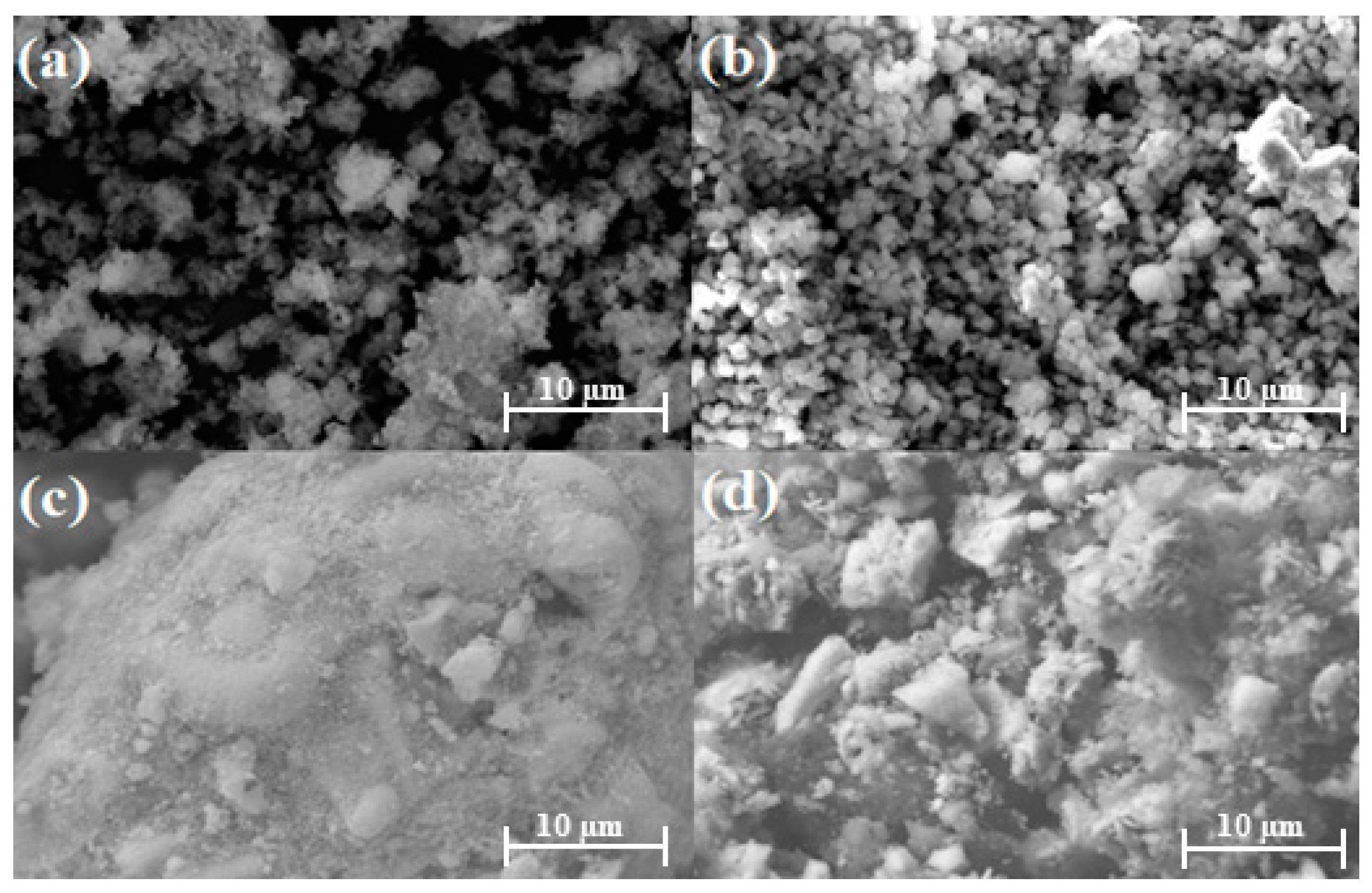
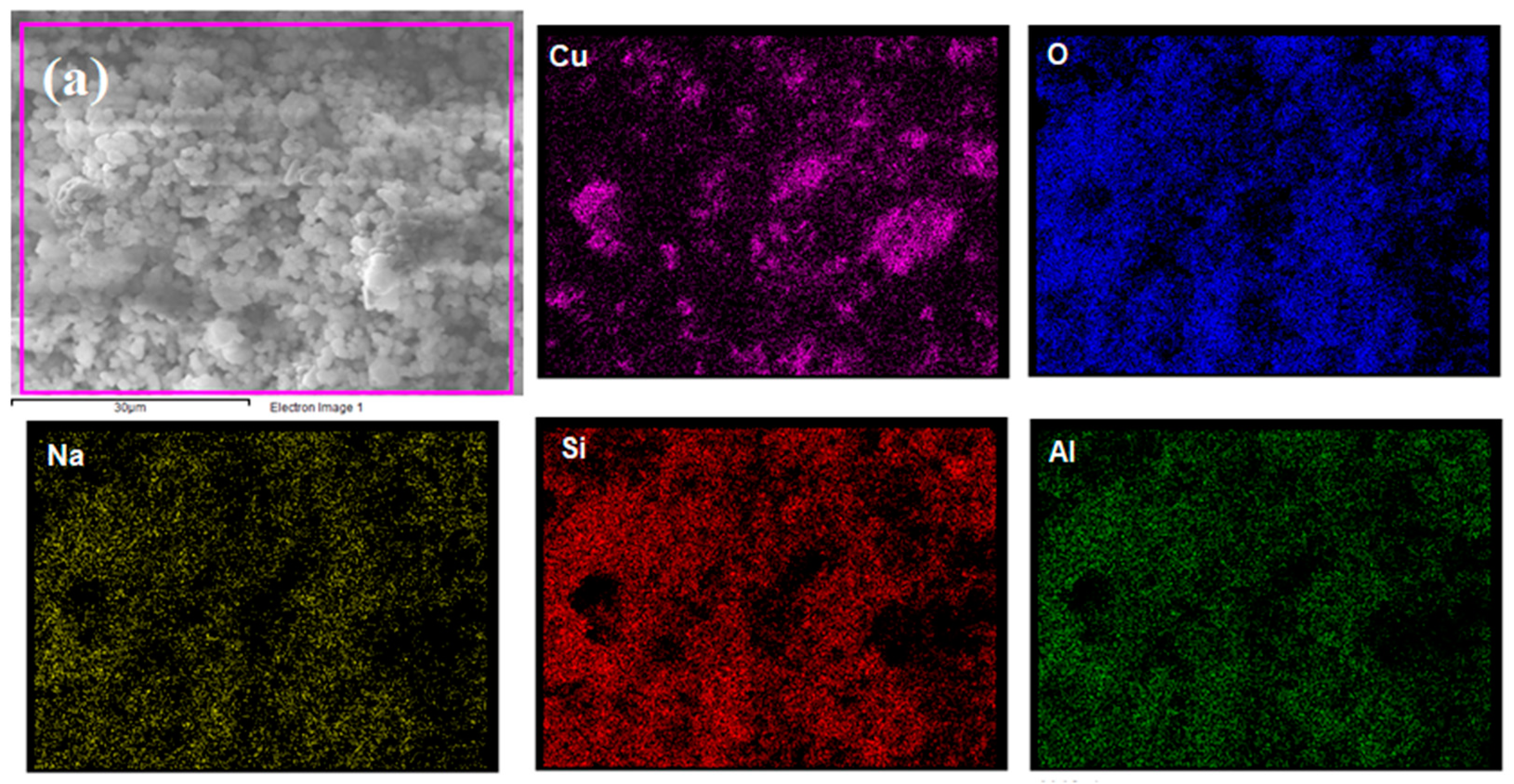
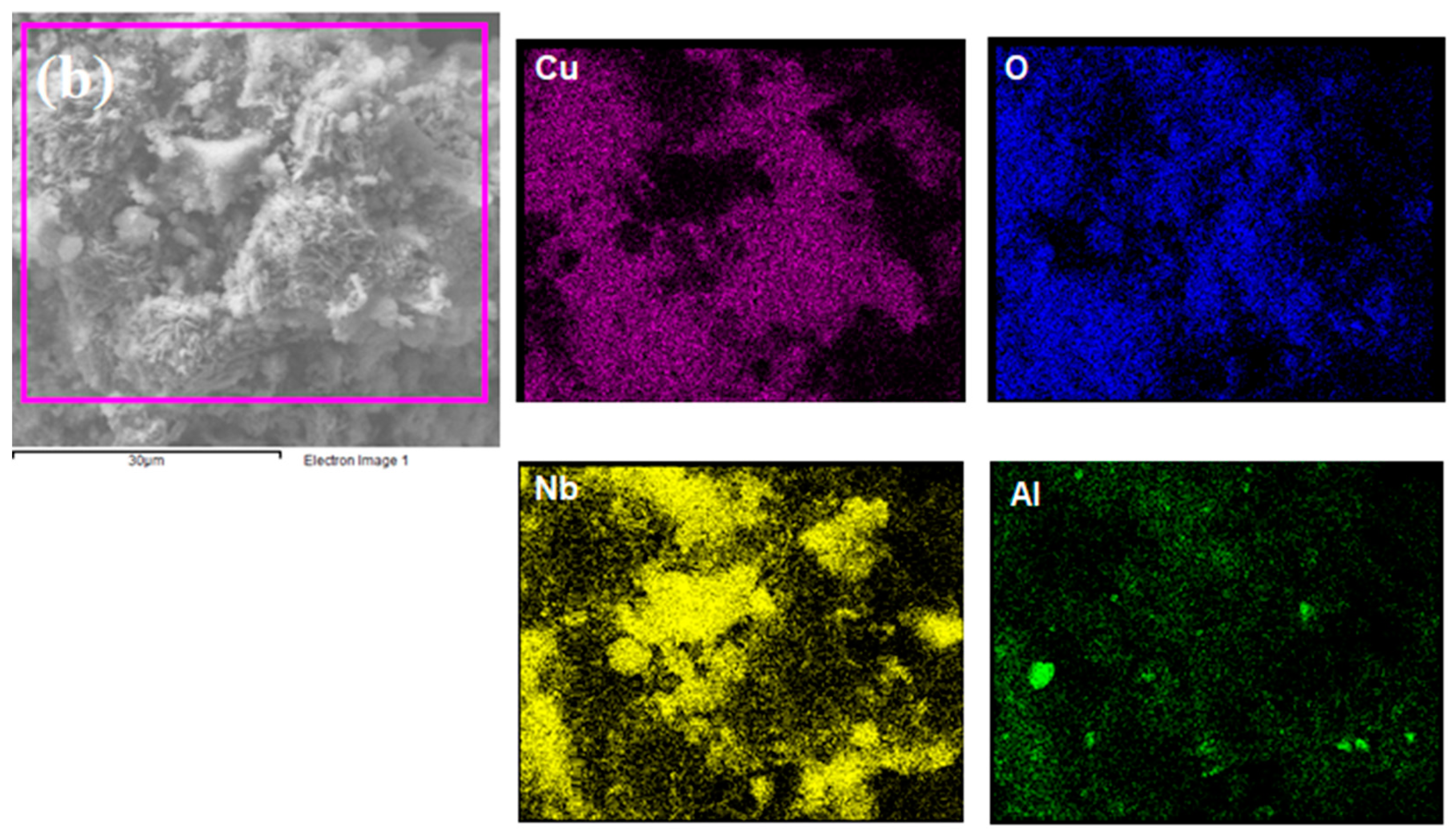
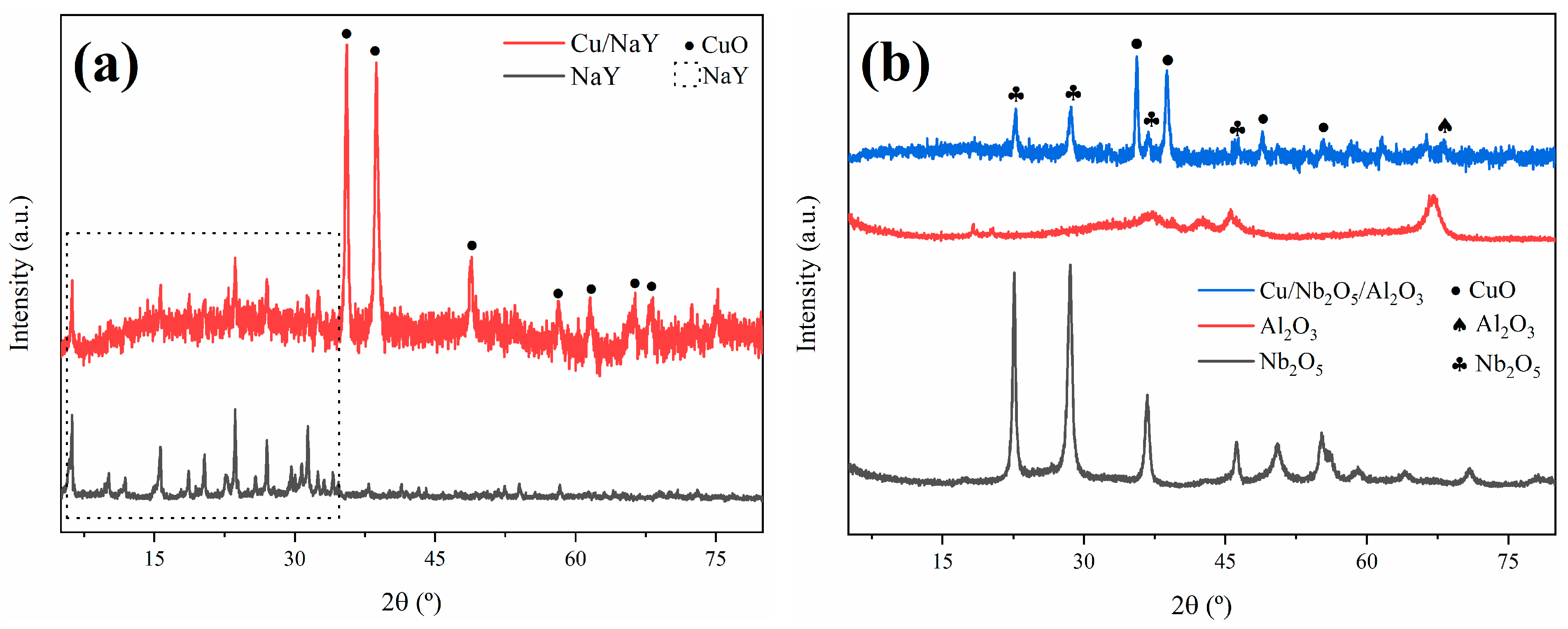


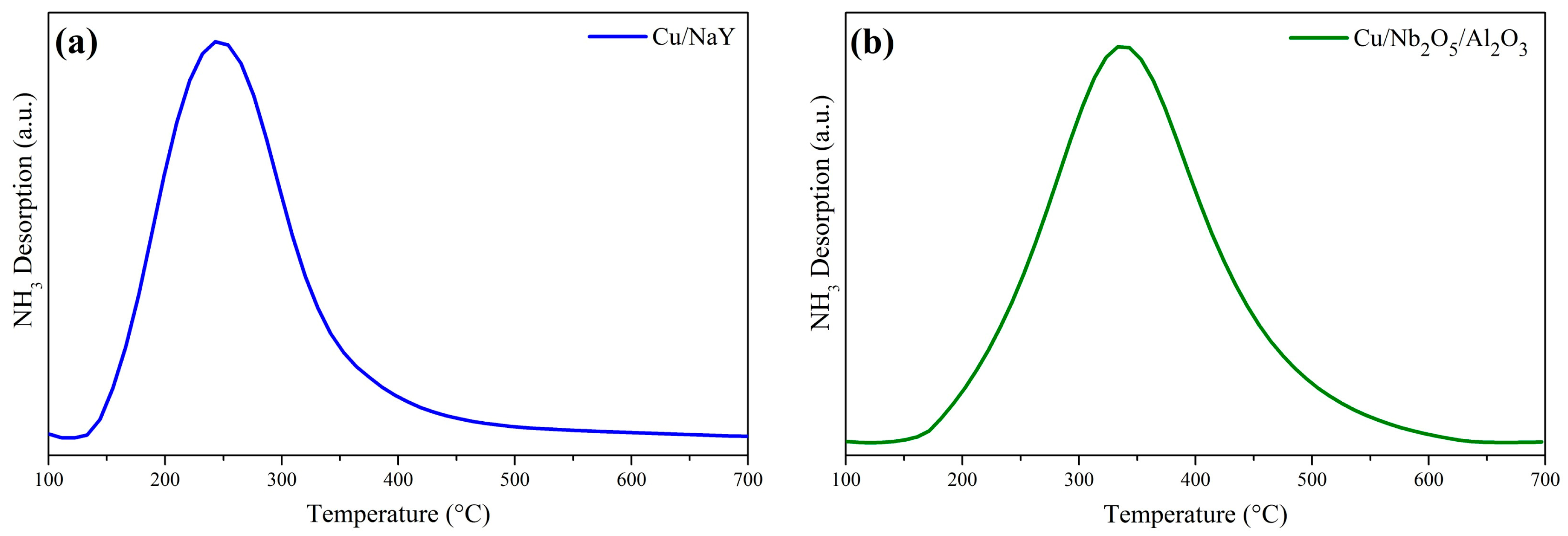

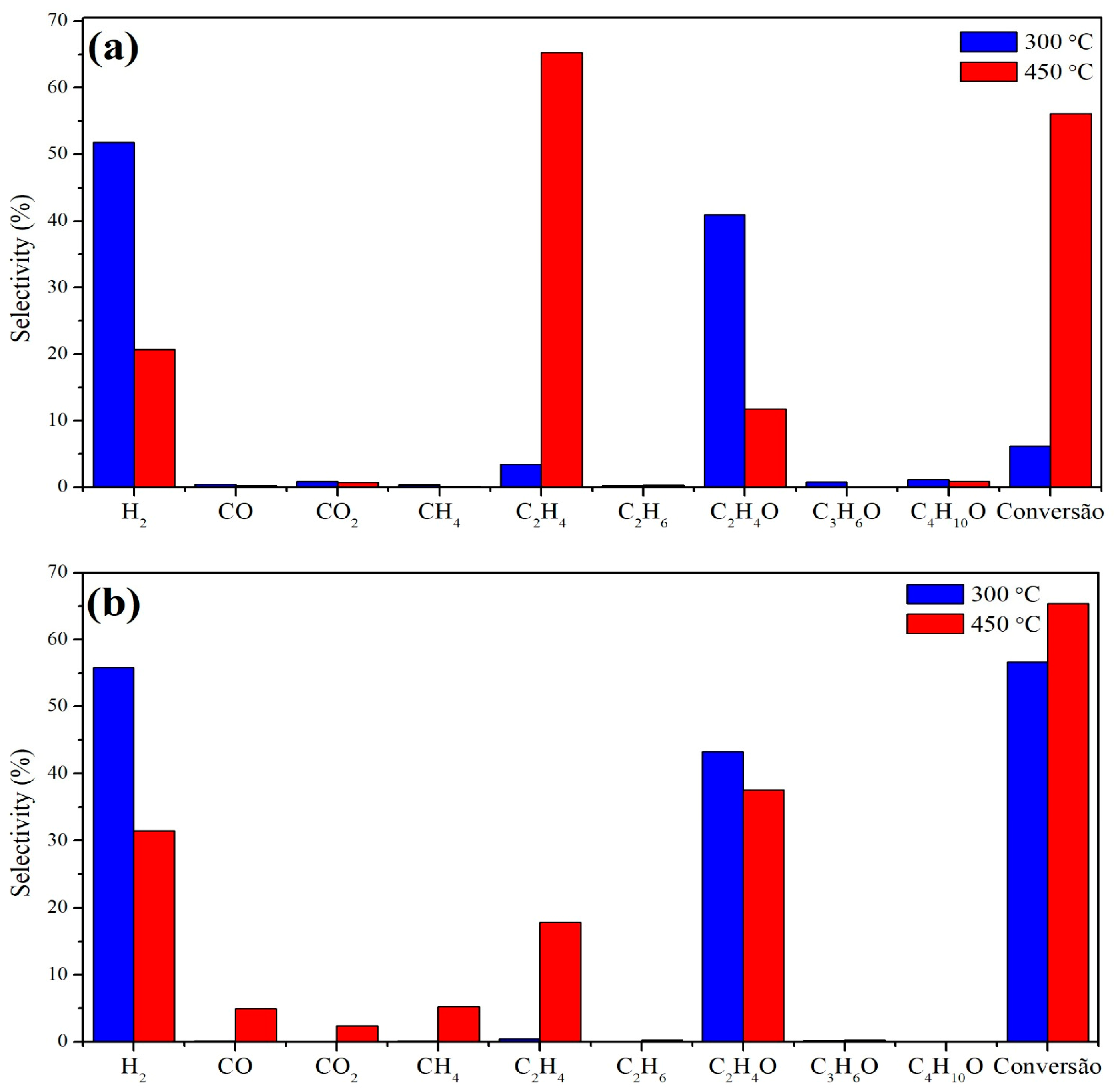
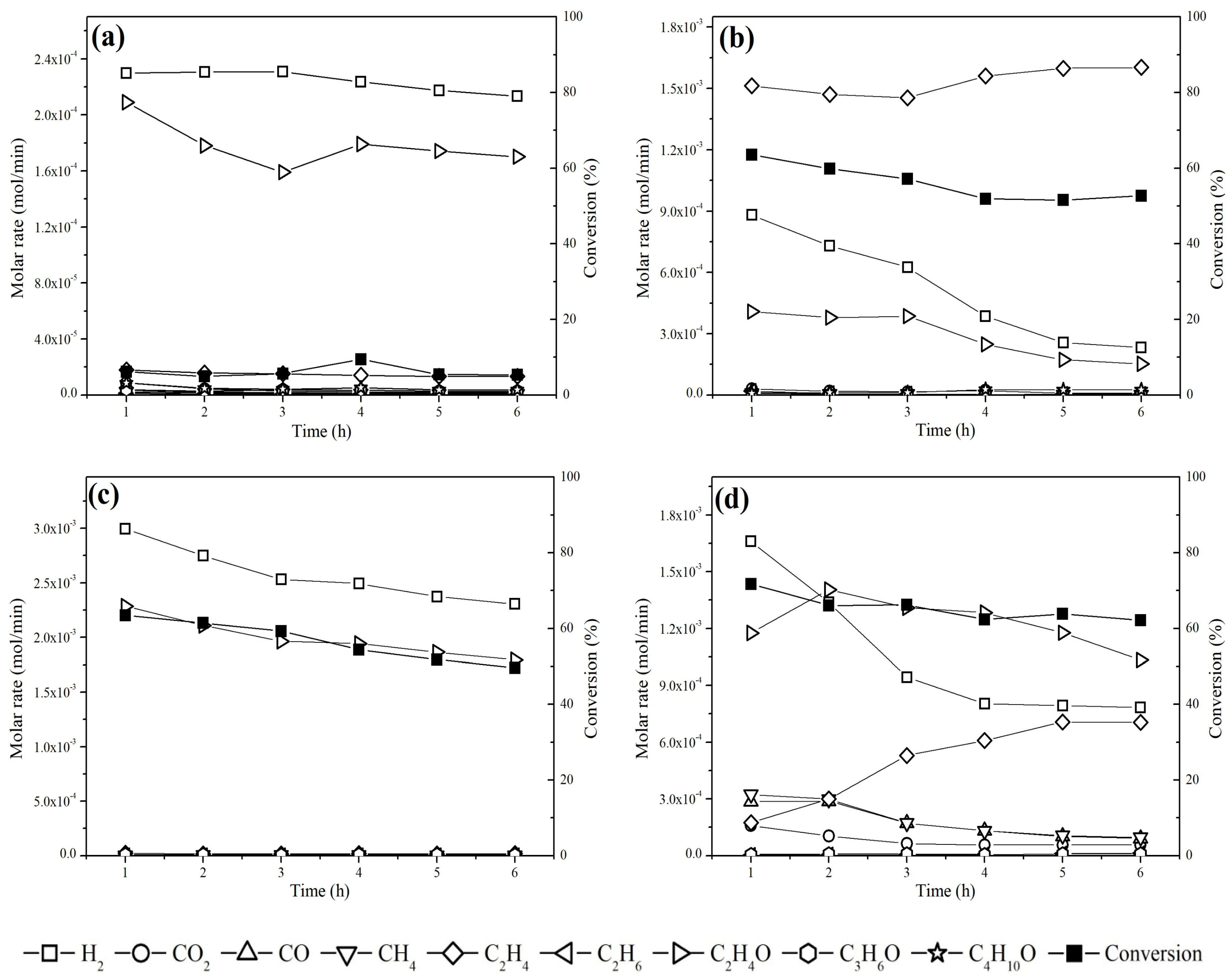
| Sample | Element (%) | ||||||
|---|---|---|---|---|---|---|---|
| Cu | Na | Al | Si | O | Nb | C | |
| Cu/NAY | 11.90 | 3.87 | 3.00 | 7.76 | 26.75 | - | 3.01 |
| Cu/Nb2O5/Al2O3 | 11.17 | - | 2.84 | - | 15.72 | 10.82 | 0.88 |
| Sample | Surface Area (m2 g−1) | Pore Volume (cm3 g−1) | Micropore Volume (cm3 g−1) | Pore Diameter (nm) |
|---|---|---|---|---|
| Nb2O5 | 71.73 | 0.3700 | 0.3200 | 8.24 |
| NaY | 588.49 | 0.1479 | 0.0281 | 1.74 |
| Al2O3 | 99.26 | 0.1799 | 0,0389 | 7.24 |
| Cu/NaY | 210.40 | 0.1180 | 0.1114 | 2.24 |
| Cu/Nb2O5/Al2O3 | 26.00 | 0.0617 | 0.0106 | 9.56 |
| Sample | Chemisorbed NH3 (mmol g−1) | Temperature (°C) |
|---|---|---|
| Cu/NaY | 1.598 | 247 |
| Cu/Nb2O5/Al2O3 | 0.059 | 336 |
Disclaimer/Publisher’s Note: The statements, opinions and data contained in all publications are solely those of the individual author(s) and contributor(s) and not of MDPI and/or the editor(s). MDPI and/or the editor(s) disclaim responsibility for any injury to people or property resulting from any ideas, methods, instructions or products referred to in the content. |
© 2024 by the authors. Licensee MDPI, Basel, Switzerland. This article is an open access article distributed under the terms and conditions of the Creative Commons Attribution (CC BY) license (https://creativecommons.org/licenses/by/4.0/).
Share and Cite
Nippes, R.P.; Macruz, P.D.; Domingues Gomes, A.; de Souza, M.; Ferreira, B.R.; Rizzo-Domingues, R.C.P.; Pereira Ramos, L. Effect of Support on Steam Reforming of Ethanol for H2 Production with Copper-Based Catalysts. Processes 2024, 12, 1331. https://doi.org/10.3390/pr12071331
Nippes RP, Macruz PD, Domingues Gomes A, de Souza M, Ferreira BR, Rizzo-Domingues RCP, Pereira Ramos L. Effect of Support on Steam Reforming of Ethanol for H2 Production with Copper-Based Catalysts. Processes. 2024; 12(7):1331. https://doi.org/10.3390/pr12071331
Chicago/Turabian StyleNippes, Ramiro Picoli, Paula Derksen Macruz, Aline Domingues Gomes, Marcos de Souza, Bruna Rodrigues Ferreira, Roberta Carolina Pelissari Rizzo-Domingues, and Luiz Pereira Ramos. 2024. "Effect of Support on Steam Reforming of Ethanol for H2 Production with Copper-Based Catalysts" Processes 12, no. 7: 1331. https://doi.org/10.3390/pr12071331
APA StyleNippes, R. P., Macruz, P. D., Domingues Gomes, A., de Souza, M., Ferreira, B. R., Rizzo-Domingues, R. C. P., & Pereira Ramos, L. (2024). Effect of Support on Steam Reforming of Ethanol for H2 Production with Copper-Based Catalysts. Processes, 12(7), 1331. https://doi.org/10.3390/pr12071331







